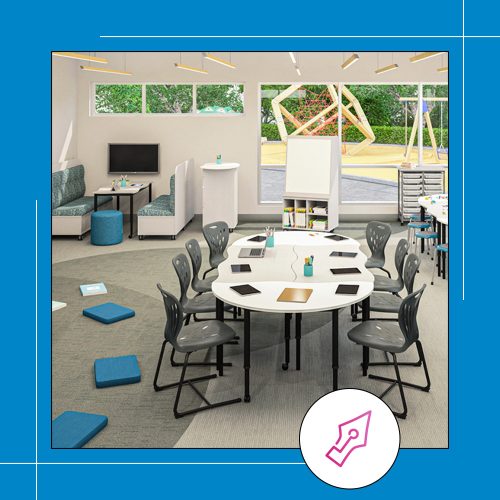...culture also has design for lunch and devours aspiration for dinner.
Our efforts to create change, to impact mindsets, habits and behaviour, and to embed new ideas, stands and falls on the culture of the users. Sinek encourages us to ‘Start With Why’, but the process of creating a sustaining culture also requires sufficient attention to the ‘how’ before embarking on the ‘what’, the ‘how’ seems to be the neglected middle child in this ‘Start With Why’ family.
Culture is described as ‘the way we do things around here’. It is evident in shared values and beliefs and supporting behaviours. Culture explains how a community is knitted together and how is experienced. The desired culture of a school or organisation needs to be the product of strategic design, if not, it develops by default. This depends on whether or not the leadership has deliberately articulated the vision and then followed through with advancing complementary practices.
When embarking on a new project, articulating design intentions present a tangible expression of the vision, providing clarity on the ‘why’. From that starting point, the aspirations can be expressed in the desire for innovative buildings and spaces, with flexible and adaptive furniture and technology. There needs to be deliberate attention to gain a shared understanding of how the affordances of the learning space will be utilised. Otherwise, it is likely that default practices used in traditional learning spaces will be shoe-horned into the new design.
The ‘how’ is the scaffold of culture, and rests on two elements, the strategy to grow your people, and the organisational elements and systems to support the vision. I have often seen these critical factors hastily addressed in the weeks leading up to the planned completion date, or worse, they are an after-thought, leaving teachers to ask, ‘What do we do now?’. Ideally, from the moment the vision is given breath, the ambitions for the new learning culture and supporting organisational structures need to be integrated, with time carved out for strategy, planning, communication and professional growth.
I was the staff development day presenter, facing a hostile crowd. The leadership had a vision (the ‘why’) for a community learning space for the Year 9 cohort. For many months, these teachers had been watching the new building (the ‘what’) take shape in the heart of their campus. However, the staff walked into the new space for the first time that morning. Rumour abounded about how they might be expected to teach. As a result, I became the object of their fear and frustration. I quickly learnt that bringing in one random outsider to present a workshop the day before school started was unlikely to address the desired culture (not the optimal ‘how’).”

Sinek, S. (2009).Start With Why: How great leaders inspire everyone to take action. New York, N.Y.: Portfolio.
The success for students within the physical environment requires a strategic approach in two key areas. Firstly, the workplace culture, embedding the desired patterns of thought and behavioural norms within the teachers, and secondly, designing the organisational structures that support the longevity of the culture.
The ‘How Factors’
Rightly so, we Start With ‘Why’ as Sinek wrote, “People don’t buy what you do; they buy why you do it”. Clarity of vision and purpose must precede all action. He also writes, “Trust is maintained when values and beliefs are actively managed.
If companies do not actively work to keep clarity, discipline and consistency in balance, then trust starts to break down.” Leadership that sustains transformation for the long haul, is focused on building a culture of trust, not control.
Sinek talks about trust being ‘actively managed’. This is the importance of the ‘how’, where ‘clarity, discipline and consistency’ are kept in balance. Managing the elements of the vision, through attention to the ‘how’ is the grunt work of leadership. How we go about activating the ‘why’ is at the heart of creating the culture we desire.
In the design of schools, there is usually clarity over the ‘why’ – a vision for a school aims to provide the best possible opportunities for the students. Perhaps your vision is something like this:
We strive to prepare all students to become lifelong learners and responsible citizens ready to meet the challenges of the future.
The vision statement deals with the ‘why’ schools exist for students. Often, I see schools jump from the ‘why’ straight to the ‘what’, so what are we going to do? In the context of the physical environment, this means designing a school that fits the brief, perhaps inspired by a pick and mix collection of ideas from schools visited, social media posts and design blogs. However, if the process from ‘why’ to ‘what’ passed through ‘how, I believe that the vision is then evident in the design, and is more sustainable, as this addresses culture change.
From my experience ‘how’ is the neglected middle child of the ‘Start With Why’ family. The middle child often feels overlooked by their parents, as they attend to the pressing needs of the eldest and youngest. However, the middle child can be the glue that holds a family together. In the same way, the ‘how’ links the ‘why’ to the ‘what’. To sustain the vision, these are the ‘how’ factors:
- Teacher culture: How do you see the vision outwork in the values, mindset and actions of teachers?
- Organisational dynamics: What practical measures will support the vision and culture?
The ‘how’ factors are not afterthoughts, but essential elements of desired culture to be embedded into the process from vision to the design. In my opinion, they can be the reason that the underlying principles of the design are not sustained.
A vision and a new space cannot solve the people issues. These need attention and a strategy.
The preferred teacher culture at your school might be student-centred team-based practice, working across faculties.
The question to ask, then, is how this might be supported by:
- Agreed values, mindsets and behaviours?
- Organising the curriculum?
- Pedagogical approaches?
- Timetables and schedules?
The ‘how’ factors are the unsung heroes, they are the unseen ‘wow factors’ of the enduring school design. They will sustain the vision long after the ribbon is cut and the stylish professional photographs fade.
Teacher Culture
How do we know what is the acceptable behaviour when we walk into a particular space – a museum, a pub or a cathedral? We have inbuilt conventions that instinctively direct our behaviour. That’s why an adult shouting in a cathedral just seems wrong to those of us familiar with the context. Culture is often instinctive.
I have been fascinated by culture for a long time. I think I have a strong culture radar, sensing the mood and tone, listening out for signals in conversations and observing interactions. Finnish academic, Pasi Sahlberg describes this as small data.
“these small clues are often hidden in the complex fabric of values, behaviours and cultures that determine what teachers and students do in school”
Vision may express the ambition and aspiration that the leader thinks is happening, but the actual ‘way we do things around here’ is the true litmus test. The prevailing culture might be too familiar for those deep within the school, a little like the frog in the kettle analogy. However, it can shout loudly to fresh eyes. The true culture is lived and breathed at the frontline, and in a school, it rests with the teachers, their values and habits of thought and behaviour.
The mantra in the business sector was once ‘the customer is always right’. This came from Selfridges at the beginning of the last century. You can imagine how this one simple statement shaped the culture, and ultimately disempowered the employee. Businesses now realise that while they need to be customer-focused, the best way to achieve this is through growing their employee’s competency to do their job, providing them with agency to make decisions and create a culture of trust. This then reaps benefits for the customer and the bottom line.
The ‘why’ is linked to vision. Obviously, a school’s publicly expressed vision is focused on the students. Parents and prospective parents want to know what this school is going to provide for their child. But how might a complementary vision for the staff help the school succeed at fulfilling the publicly proclaimed vision, how might it impact the student experience? What if you had a vision for your staff?
Our vision is to have a school of happy teachers who are fulfilled in their work.
Schools once had a culture of control, executed with military precision – walk in lines, sit where I tell you, silence. The teachers were authoritarian and reflected this sense of control. We are now shifting toward valuing agency and relationship as integral elements of culture. Agency refers to being empowered to make choices, while we know that the quality of relationships make the difference to our wellbeing and productivity.
To unpack that teacher-vision a little further, the concepts of happiness and fulfilment work together. Happy, does not mean that leadership acquiesce to every desire, but that the basics of human need are met, including to be heard, appreciated, and equipped for the role. When we feel we are making progress and a positive contribution to society, we are fulfilled. Happy and fulfilled people are not those who isolate themselves, who shirk from responsibilities or complain all the time. These people are the challenges that all leaders face. But the force of the positive culture can eventually outweigh the negative influences.
The next question relates to how we practically make this happen. Are happy and fulfilled teachers:
- Working to their strengths?
- Part of an effective team?
- Working within a structure that enables them to flourish?
The bottom line is, we can put all this down on paper, but what does it mean in the everyday life of the school?













